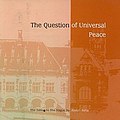|
Tablet to The Hague
The Tablet to The Hague is a letter which ʻAbdu'l-Bahá wrote to the Central Organisation for Durable Peace in The Hague, The Netherlands on 17 December 1919. Historical backgroundWhen the Central Organization for Durable Peace came together, it published its constitution in newspapers all over the world. This was read by Mr. Ahmad Yazdání who in consultation with Hand of the Cause Mr. Ibn-i-Asdaq wrote a paper to the organization informing them about the Baháʼí Principles and suggesting they seek guidance from ʻAbdu'l-Bahá regarding their aim to establish universal peace.[1] The organization wrote a letter through Mr. Yazdání to ʻAbdu'l-Bahá dated February 11, 1916. When the letter arrived ʻAbdu'l-Bahá revealed the "Tablet to The Hague" which was delivered in person to the organization by Mr. Yazdání and Mr. Ibn-i-Asdaq in June 1920. The letter was dated February 11, 1916, but this letter did not arrive for many years due to the war.[2] By the time the letter arrived the organization had already been disbanded in June 1919 after the signing of the treaty of Versailles.[3] Content of the TabletIn the tablet, ʻAbdu'l-Bahá gives an overview of Baháʼí principles, which include the following:
He declares that the League of Nations is "incapable of establishing universal peace", and calls for the establishment of a Supreme Tribunal, representing all countries:
Second Tablet to the HagueThe organization wrote a response to the "Tablet to the Hague" on the 12th of June 1920. ʻAbdu'l-Bahá responded with a second, shorter tablet to the Hague on the July 12, 1920.[4][5] See alsoNotes
References
External links |
Portal di Ensiklopedia Dunia

